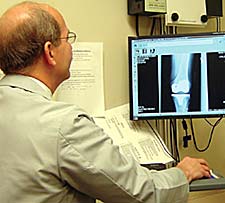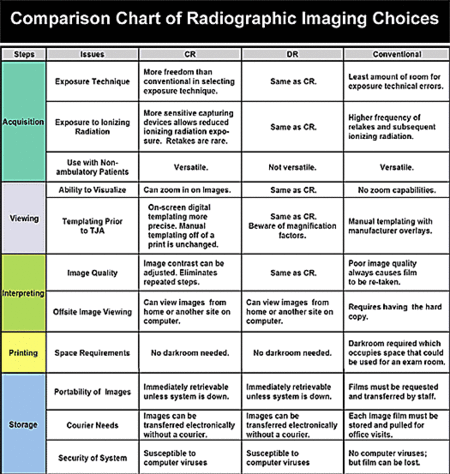Illinois surgeons face challenges embracing digital radiography
One orthopedic clinic successfully converted to a computed imaging system after encountering snags with digital radiography.
Courtesy of Jill Branson |
As the staff at the Illinois Bone and Joint Institute found out, making the switch from conventional radiography to digital imaging can pose its share of obstacles, despite making gains in resolution.
The institute installed both digital and computed radiography in one center and maintained conventional radiography in another. The staff found it harder to perform exams and had difficulties with template size using digital radiography (DR).
They had so many problems that they fired the vendor, got rid of the DR system and outfitted their office with additional computed radiography (CR) units.
“Our experience has found that CR, not DR, may be the optimal current technology for digital imaging in a large, multispecialty orthopaedic practice,” the staff wrote in a handout distributed at the American Academy of Orthopaedic Surgeons 72nd Annual Meeting.
Magnification
“Some of the problems we first encountered with our original PACS [Picture Archiving and Communication System] vendor was that this system didn’t live up to the expectations,” the PACS administrator at the institute, Joseph Stark, RT, told Orthopedics Today.
A research committee for the institute hoped that the original DR and CR units would allow them to create digital templates. Instead of easy-to-apply printouts, the DR system created larger images that required mathematical conversion.
The images were fixed at a 60-inch source-to-image distance (SID) compared to the 40-inch SID of conventional images. Implant vendors use this 40-inch SID as a standard, Stark said, “so when you use images that are taken at a 60-inch SID, your magnification factors are completely different and … then you have the wrong measurements [for surgery].”
The PACS vendor for the DR units suggested magnification markers to fix the problem.
“But again, it didn’t really serve a great purpose because the doctors would have to change the templates or would have to actually make the conversions themselves from the measurements,” Stark said.
Vendor trouble
|
The staff discovered that the bulky DR unit also increased imaging time.
“Some of our smaller technologists would need to double up in order to move the [imaging] table because, once you combine the weight of the table and the weight of the patient, it was extremely difficult to move by yourself,” Stark said.
The table was set at a fixed height and made it difficult for examining children or patients with limited motion, the staff wrote in their handout.
Again, the staff found that the vendor provided limited solutions. The vendor told the group that a new table was being designed, but it was still in the research and development stages.
Stark would not disclose the name of the vendor or manufacturer of the units to Orthopedics Today. “We had too many bad experiences with our first vendor, so we decided that we had to make a change,” he said. “And we went with a different PACS vendor and also eliminated the DR unit all together,” Stark said.
Transition to CR
After installing a new CR unit, the staff could move patients from the X-ray room faster than with DR, Stark said.
In fact, the total time using CR, including storage and interpretation, was faster than DR (14 vs. 17 minutes, respectively) and conventional imaging (42 minutes), the staff wrote.
The new system also proved cost-effective, as the center eliminated the chemicals and film needed for conventional imaging.
The Illinois Bone and Joint Institute also hired a new, cooperative PACS vendor, who provided a week of training for staff before and after using the system for the first time, Stark said.
Current plans for the institute include expanding the digital office and digitizing their final site.
|
|
For more information:
- Goldstein WM, Visotsky JL, Wold DJ, et al. Conversion to digital radiography in the orthopaedic office practice: The move to digital imaging. Distributed at the American Academy of Orthopaedic Surgeons 72nd Annual Meeting. Feb. 23-27, 2005. Washington.


